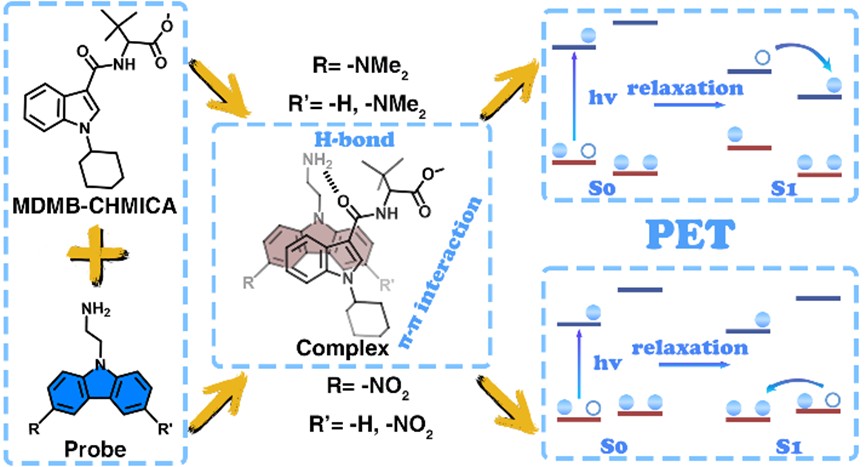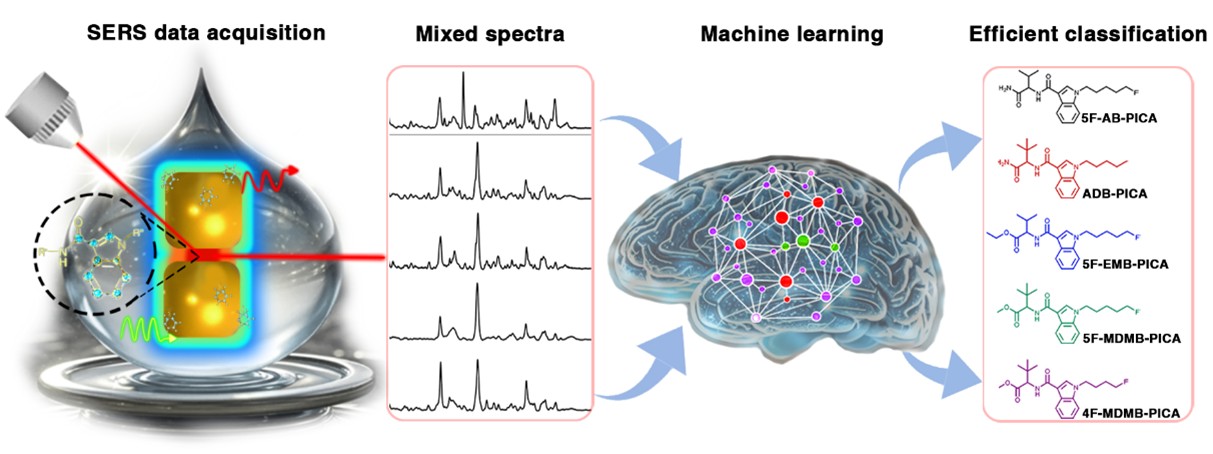Progres in Detection Synthetic Cannabinoids
Editor: | Jun 28,2025
Third-generation new psychoactive substances (NPS), represented by synthetic cannabinoids (SCs), are characterized by their species diversity, simple synthesis, and rapid iteration. SCs with indole, indazole, carbazole, pyrazole, indazole-3-carboxamide, pyrrolo[2,3-b]pyridine, and benzimidazole as their structural frameworks constitute the main components of NPS. Smilar to Δ9-THC, SCs are agonists of the cannabinoid receptor type 1 (CB1R), thereby produced analgesic, appetite-stimulating, and mood-regulating effects by activating CB1R. Misuse or overdose of SCs can lead to dizziness, nausea, vomiting, respiratory depression, cardiovascular disease, acute kidney injury, and even death. Due to their psycho-toxicity and addictive potential, SCs pose significant threats to human health and public safety. However, there are currently no rapid on-site testing methods for the detection of SCs, which poses challenges for drug control efforts. Therefore, developing rapid, highly sensitive detection methods for synthetic cannabinoids is of great significance for maintaining public health safety and social stability.
Fluorescence sensing technology, with its advantages of fast response speed, high specificity, and ease of operation, has become an important technical tool in fields such as environmental monitoring and rapid drug screening. However, the development of fluorescent probes faces challenges such as lengthy experimental cycles and high trial-and-error costs. To address this issue, the Trace Chemical Substance Sensing Team at the XinJiang Technical Institute of Physics and Chemistry Chinese Academy of Sciences utilized the intrinsic physicochemical properties of synthetic cannabinoid molecules and their binding patterns with CB1 receptors as guidance. Some probes were designed by incorporating recognizing groups onto the carbazole fluorophore to mimic CB1 receptor/SC binding interactions. DFT computational results showed that the introduction of electron-donating/accepting groups affects the molecular orbital energy level arrangement of the probes. CSN and CDN probes with electron-accepting groups exhibit significantly lower molecular orbital energy levels than CSD and CDD probes with electron-donating groups. Additionally, the conjugated system extending effect of nitro group leads to a red shift in the fluorescence emission peak of CSN and CDN. The independent gradient model analysis revealed that the carbazole-based probes recognizing MDMB-CHMICA by forming hydrogen bonding interaction, π-π interactions, and hydrophobic interactions with it. Theoretical spectral simulations and frontier molecular orbital analysis fully elucidated the photoinduced electron transfer (PET) mechanism leading to the probe/MDMB-CHMICA complex fluorescence quenching. Similar to CB1 receptor binding with SCs, four fluorescent probes were designed to recognizing MDMB-CHMICA via non-covalent interaction, which provide guidance for the development of optical probes for other new psychoactive substance detection.
This work was published in the journal ACS Omega under the title “Noncovalent Interaction-Based Probe Design for PET-Facilitated Fluorescence Sensing of Synthetic Cannabinoids”, Jiahao Dong, a joint master’s student from Xinjiang University, and Dr. Chuanfang Zhao from Xinjiang Technical Institute of Physics and Chemistry was the co-first authors, and Prof. Xincun Dou is the corresponding author. This work was supported by the Xinjiang Key Research and Development Program, the Tianshan Innovation Team Project, and the Tianchi Talent Program.

Figure 1 Noncovalent Interaction-Based Probe Design for PET-Facilitated Fluorescence Sensing of Synthetic Cannabinoids
In addition, in response to the practical needs of detecting SCs, which are characterized by rapid iterative updates and a wide variety of types, the Trace Chemical Substance Sensing Team at the XinJiang Technical Institute of Physics and Chemistry Chinese Academy of Sciences proposed an identification strategy based on SERS technology coupled with machine learning. Starting from the computational simulation analysis of molecular structures, they performed geometric optimization and vibration frequency calculations on five typical SCs molecules and simulated the Raman spectra of SCs. Through potential energy distribution analysis (PED), the molecular vibrational groups corresponding to the Raman characteristic peaks of SCs were identified. At the same time, gold nanocubes substrate materials with a “hot spot” effect were designed and synthesized, and based on this, high-quality SERS spectral data for each type of SC was obtained and a machine learning database was established. Further classification was achieved by adopting preprocessing methods such as dimension reduction and smoothing, as well as different machine learning classification model algorithms. Among these, the SVM classification model demonstrated significantly superior classification performance compared to other algorithms in iterative training and 10-fold cross-validation, achieving an accuracy rate of 100% in both cases. In addition, based on attribution algorithms and PED analysis, the identification mechanism of SCs molecular common group vibration peaks and characteristic group vibration peaks in the classification process of the SVM model was analyzed, revealing the physical and chemical sources of Raman peaks identified by machine learning algorithms. The attribution algorithm not only confirmed that the model’s decision-making ability is closely related to molecular vibration modes, but also verified the model's generalization ability. This strategy provides new insights into the classification interpretation of SVM models and enables the accurate differentiation of substances with highly similar structures.
This work was published in Sensors and Actuators B: Chemical entitled as “Differentiation and Identification of CA Series Synthetic Cannabinoids Based on SERS Technology Coupled with Support Vector Machine”, Wenlong Li, a joint master’s student from Xinjiang University, and Dr. Yuwan Du from Xinjiang Technical Institute of Physics and Chemistry was the co-first authors, and Prof. Xincun Dou is the corresponding author. This work is financially supported by the National Natural Science Foundation of China, the Key Research and Development Program of Xinjiang and Tianshan Innovation Team Plan.

Figure 2 Distinguishing and Identifying CA Series Synthetic Cannabinoids Based on SERS Technology Coupled with Machine Learning.
附件下载:
 (86) 991-3838931
(86) 991-3838931 lhskj@ms.xjb.ac.cn
lhskj@ms.xjb.ac.cn (86)991-3838957
(86)991-3838957 40-1 Beijing Road
Urumqi, XinjiangChina
40-1 Beijing Road
Urumqi, XinjiangChina